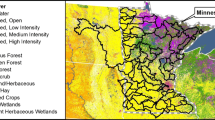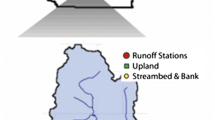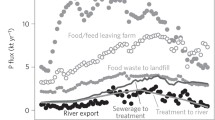Abstract
Assessments of long-term relationships between changes innutrient inputs and wetland nutrient concentrations can becomplicated by fluctuations in other environmental factors aswell as by problems typical of long-term monitoring data.Consequently, statistical analysisof these types of data sets requirescareful consideration of environmental covariates, potentialbiases in the monitoring design, and irregularities caused bychanges in field sampling protocols. We evaluated therelationship between anthropogenic phosphorus (P) inputs andwater-column total P (TP) concentrations in a northernEverglades marsh by statistically analyzing available datacollected from several sampling programs over the past 20 years(1978–1997). Canal inputs of agricultural runoff contributemost of the P to the marsh and have produced a zone ofenrichment within the marsh during the past few decades.Regression analyses showed that both canal and marsh TPconcentrations increased during the 1980s and then decreased inthe 1990s. However, the statistical relationship between canal Pinputs and marsh TP, while significant, generally was weakexcept for marsh locations adjacent to the canal. Strongerrelationships existed between marsh TP and hydrologic parameterssuch as marsh water depth, which is controlled by changes inweather patterns and marsh management. In particular, dryconditions during the 1980s may have contributed to observedincreases in marsh P concentrations and the movement of a P`front' further into the marsh. Higher rainfall and water depthsand agricultural best management programs initiated during the1990s have been associated with reduced P concentrations incanal waters entering the marsh. While it is anticipated thatthis reduction eventually will result in lower marsh TPconcentrations, this effect is not yet evident, possibly due tointernal loading of P from enriched marsh soils. Our findingsillustrate some of the environmental factors that can complicateattempts to develop empirical relationships between P inputs andwetland P concentrations and to use such relationships to forecast changesin marsh concentrations based on past monitoring data alone.
Similar content being viewed by others
References
Davis, S. M.: 1982, ‘Patterns of radiophosphorus accumulation in the Everglades after its introduction 0into surface water'. Technical Publication 82–2, South Florida Water Management District, West Palm Beach, Florida.
Davis, S. M.: 1994, ‘Phosphorus Inputs and Vegetation Sensitivity in the Everglades', in S.M. Davis and J. C. Ogden (eds), Everglades: The Ecosystem and its Restoration, St. Lucie Press, Delray Beach, Florida, pp. 357–378.
Esterby, S.: 1995, ‘A review of methods for the detection and estimation of trends with emphasis on water quality applications', Hydrol. Process. 10, 127–149.
Faulkner, S. P. and de la Cruz, A. A.: 1982, ‘Nutrient mobilization following winter fires in an irregularly flooded marsh', J. Environ. Qual. 11, 129–133.
Gleason, P. J., Stone, P. and Rosen, M.: 1974, ‘Nutrient uptake and rates of nutrient deposition in Conservation Area 2A'. Unpublished technical document, Environmental Sciences Division, South Florida Water Management District, West Palm Beach, Florida.
Godfrey, P. J., Kaynor, E. R., Pelczarski, S. and Benforado, J. (eds): 1985, Ecological Considerations in Wetlands Treatment of Municipal Wastewaters, Von Nostrand Reinhold Co., New York.
Havens, K. E., Aumen, N. G., James, R. T. and Smith, V. H.: 1996, ‘Rapid ecological changes in a large subtropical lake undergoing cultural eutrophication', Ambio 25, 150–155.
Havens, K. E., East, T. L., Hwang, S.-J., Rodusky, A. J., Sharfstein, B. and Steinman, A. D.: 1999, ‘Algal responses to experimental nutrient additions in the littoral community of a subtrophical lake', Freshw. Biol. 42, 1–16.
Helsel, D. R. and Hirsch, R.M.: 1992, Statistical Methods in Water Resources, Elsevier, Amsterdam.
Howard-Williams, C.: 1985, ‘Recycling and retention of nitrogen and phosphorus in wetlands: theoretical and applied perspective', Freshw. Biol. 15, 391–431.
Jeppesen, E., Kristensen, P., Jensen, J. P., Sondergaard, M., Mortensen, E. and Lauridsen, T.: 1991, ‘Recovery resilience following a reduction in external phosphorus loading of shallow, eutrophic Danish lakes: duration, regulating factors and methods for overcoming resilience'. Men. Ist. Ital. Idrobiol. 48, 127–148.
Light, S. S. and Dineen, J. W.: 1994, ‘Water Control in the Everglades: A Historical Perspective', in S. M. Davis and J. C. Ogden (eds), Everglades: The Ecosystem and Its Restoration, St. Lucie Press, Delray Beach, Florida, pp. 47–84.
Lin, P.-E. and Niu, X.-F.: 1999, ‘Statistical analysis and summary of the Everglades Round Robin (ERR) exercises'. Unpublished technical document, Florida Department of Environmental Protection, Tallahassee, Florida.
McCormick, P. V., Rawlik, P. S., Lurding, K., Smith, E. P. and Sklar, F. H.: 1966, ‘Periphyton-water quality relationships along a nutrient gradient in the northern Everglades', J. N. Am. Benthol. Soc. 15, 433–449.
Moshiri, G. A. (ed.): 1993, Constructed Wetlands for Water Quality Improvement, Lewis Publishers, Boca Raton, Florida.
Rader, R. B. and Richardson, C. J.: 1994, ‘Response of macroinvertebrates and small fish to nutrient enrichment in the northern Everglades', Wetlands 14, 134–146.
Reddy, K. R., White, J. R., Wright, A. L. and Chua, T.: 1999, ‘Influence of Phosphorus Loading on Microbial Processes in Soil and Water Column of Wetlands', in K. R. Reddy, G. A. O'Connor and C. L. Schelske (eds), Phosphorus Biogeochemistry in Sub-Tropical Ecosystems: Florida as a Case Example, CRC/Lewis Publishers, Boca Raton, Florida, pp. 249–274.
Rutchey, K. and Vilchek, L.: 1994, ‘Development of an Everglades vegetation map using a SPOT image and the Global Positioning System', Photogram. Eng. Remote Sen. 60, 767–775.
Rutchey, K. and Vilchek, L.: 1999, ‘Air photo interpretation and satellite imagery analysis techniques for mapping cattail coverage in a northern impoundment', Photogram. Eng. Remote Sen. 65, 185–191.
SAS Institute, Inc.: 1996, Forecasting Examples for Business and Economics Using the SAS System, SAS Institute, Inc., Cary, North Carolina.
SFWMD: 1997, ‘Everglades Best Management Practice Program', Regulation Department, South Florida Water Management District, West Palm Beach, Florida.
Stow, C. A., Carpenter, S. R., Webster, K. E. and Frost, T. M.: 1998, ‘Long-term environmental monitoring: some perspectives from lakes', Ecol. Appl. 8, 269–276.
Swift, D. R. and Nicholas, R. B.: 1987, ‘Periphyton and water quality relationships in the Everglades Water Conservation Areas, 1978–1982', Technical Publication 87–2, South FloridaWater Management District, West Palm Beach, Florida.
Urban, N. H., Davis, S. M. and Aumen, N. G.: 1993, ‘Fluctuations in sawgrass and cattails in the everglades water conservation area 2A under varying nutrient, hydrologic, and fire regimes', Aquat. Bot. 46, 203–223.
US EPA: 1983, Methods for the Chemical Analysis of Water and Wastes, EPA-600/4–79–020, revised, Office of Research and Development, United States Environmental Protection Agency, Cincinnati, Ohio. US EPA: 1985, Freshwater Wetlands for Wastewater Management Handbook, EPA 904/9–85–135, United States Environmental Protection Agency, Region IV, Atlanta, Georgia.
Walker Jr., W.W.: 1995, ‘Design basis for Everglades stormwater treatment areas'. Wat. Resour. Bull. 31, 671–685.
Walker Jr., W. W.: 1999, ‘Long-Term Water Quality Trends in the Everglades', in Reddy, K. R., O'Connor, G. A. and Schelske, C. L. (eds), Phosphorus Biogeochemistry in Sub-tropical Ecosystems: Florida as a Case Example, CRC/Lewis Publishers, Boca Raton, Florida, pp. 447–466.
Worth, D. F.: 1988, ‘Environmental response of WCA-2A to reduction in regulation schedule and marsh drawdown', Technical Publication 88–2, South Florida Water Management District, West Palm Beach, Florida.
Author information
Authors and Affiliations
Corresponding author
Rights and permissions
About this article
Cite this article
Smith, E.P., McCormick, P.V. Long-Term Relationship between Phosphorus Inputs and Wetland Phosphorus Concentrations in a Northern Everglades Marsh. Environ Monit Assess 68, 153–176 (2001). https://doi.org/10.1023/A:1010798628940
Issue Date:
DOI: https://doi.org/10.1023/A:1010798628940




